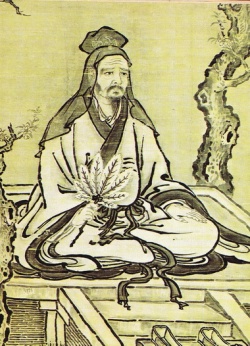Difference between revisions of "Ashvajit"
| (One intermediate revision by the same user not shown) | |||
| Line 1: | Line 1: | ||
[[File:Ea ilFP.jpg|thumb|250px|]] | [[File:Ea ilFP.jpg|thumb|250px|]] | ||
| + | |||
| + | |||
| + | |||
| + | |||
| + | |||
| + | |||
| + | |||
[[Aśvajit]]. (P. [[Assaji]]; T. [[Rta thul]]; C. [[Ashuoshi]]; J. [[Asetsuji]]; K. [[Asŏlsi]] [[阿示]]). | [[Aśvajit]]. (P. [[Assaji]]; T. [[Rta thul]]; C. [[Ashuoshi]]; J. [[Asetsuji]]; K. [[Asŏlsi]] [[阿示]]). | ||
The fifth of the [[five ascetics]] ([[Pañcavargika]]), along with [[Ājñātakauṇḍinya]] (P. [[Aññātako ṇḍañña]]) , [[Bhadrika]] (P. [[Bhaddiya]]), [[Vāṣpa]] (P. [[Vappa]]), and [[Mahānāman]] (P. [[Mahānāma]]), who practiced austerities with [[Gautama]] prior to his [[enlightenment]]. | The fifth of the [[five ascetics]] ([[Pañcavargika]]), along with [[Ājñātakauṇḍinya]] (P. [[Aññātako ṇḍañña]]) , [[Bhadrika]] (P. [[Bhaddiya]]), [[Vāṣpa]] (P. [[Vappa]]), and [[Mahānāman]] (P. [[Mahānāma]]), who practiced austerities with [[Gautama]] prior to his [[enlightenment]]. | ||
| + | |||
Subsequently, when [[Gautama]] abandoned the severe [[asceticism]] they had been practicing in favor of the [[middle way]] ([[Madhyamapratipad]]), [[Aśvajit]] and his companions became disgusted with [[Gautama’s]] backsliding and left him, going to the [[Ṛṣipatana]] (P. | Subsequently, when [[Gautama]] abandoned the severe [[asceticism]] they had been practicing in favor of the [[middle way]] ([[Madhyamapratipad]]), [[Aśvajit]] and his companions became disgusted with [[Gautama’s]] backsliding and left him, going to the [[Ṛṣipatana]] (P. | ||
| Line 10: | Line 18: | ||
After the [[Buddha’s]] [[enlightenment]], however, the [[Buddha]] sought them out to teach them the [[first sermon]], the [[Dharmacakrapravartanasūtra]] (P. [[Dhammacakkapavattanasutta]]); | After the [[Buddha’s]] [[enlightenment]], however, the [[Buddha]] sought them out to teach them the [[first sermon]], the [[Dharmacakrapravartanasūtra]] (P. [[Dhammacakkapavattanasutta]]); | ||
| − | while listening to this {{Wiki|sermon}}, [[Aśvajit]] achieved the | + | while listening to this {{Wiki|sermon}}, [[Aśvajit]] achieved the first stage of [[awakening]] or “opening of the [[dharma eye]]” ([[Dharmacakṣus]]), becoming a [[stream-enterer]] ([[Srotaāpanna]]), and was immediately [[ordained]] as a [[monk]] using the informal [[Ehibhikṣukā]], or “come, [[monk]],” [[formula]]. |
Five days later, the [[Buddha]] then [[preached]] to the group of five new [[monks]] the second {{Wiki|sermon}}, the *[[Anātmalakṣaṇasūtra]] (P. [[Anattalakkhaṇasutta]]), which led to [[Aśvajit’s]] becoming [[a worthy one]] ([[Arhat]]). | Five days later, the [[Buddha]] then [[preached]] to the group of five new [[monks]] the second {{Wiki|sermon}}, the *[[Anātmalakṣaṇasūtra]] (P. [[Anattalakkhaṇasutta]]), which led to [[Aśvajit’s]] becoming [[a worthy one]] ([[Arhat]]). | ||
Latest revision as of 10:22, 17 April 2024
Aśvajit. (P. Assaji; T. Rta thul; C. Ashuoshi; J. Asetsuji; K. Asŏlsi 阿示).
The fifth of the five ascetics (Pañcavargika), along with Ājñātakauṇḍinya (P. Aññātako ṇḍañña) , Bhadrika (P. Bhaddiya), Vāṣpa (P. Vappa), and Mahānāman (P. Mahānāma), who practiced austerities with Gautama prior to his enlightenment.
Subsequently, when Gautama abandoned the severe asceticism they had been practicing in favor of the middle way (Madhyamapratipad), Aśvajit and his companions became disgusted with Gautama’s backsliding and left him, going to the Ṛṣipatana (P.
Isipatana) deer park, located in the northeast of Vārāṇasī.
After the Buddha’s enlightenment, however, the Buddha sought them out to teach them the first sermon, the Dharmacakrapravartanasūtra (P. Dhammacakkapavattanasutta);
while listening to this sermon, Aśvajit achieved the first stage of awakening or “opening of the dharma eye” (Dharmacakṣus), becoming a stream-enterer (Srotaāpanna), and was immediately ordained as a monk using the informal Ehibhikṣukā, or “come, monk,” formula.
Five days later, the Buddha then preached to the group of five new monks the second sermon, the *Anātmalakṣaṇasūtra (P. Anattalakkhaṇasutta), which led to Aśvajit’s becoming a worthy one (Arhat).
It was through an encounter with Aśvajit that Śāriputra and Mahāmaudgalyāyana, the Buddha’s two chief disciples, were initially converted. Sāriputra witnessed Aśvajit’s calm demeanor while gathering alms in the city of Rājagṛha.
Impressed, he approached Aśvajit and asked who his teacher was and what were his teachings.
In response, Aśvajit said that he was new to the teachings and could offer only the following summary:
“Of those phenomena produced through causes, the Tathāgata has proclaimed their causes and also their cessation.
Thus has spoken the great renunciant.”
His description, which came to known as the Ye Dharmā (based on its first two words of the summary), would become perhaps the most commonly repeated statement in all of Buddhist literature.
Upon hearing these words, Śāriputra attained the stage of stream-entry (see Srotaāpanna), and when he repeated what he heard to his friend Maudgalyāyana, he also did so.
The two then agreed to become the Buddha’s disciples. According to Pāli sources, Aśvajit once was approached by the ascetic Nigaṇṭha Saccaka, who inquired of the Buddha’s teachings.
Aśvajit explained the doctrine of nonself (Anātman) with a summary of the Anattalakkhaṇasutta, which the Buddha had taught him.
Convinced that he could refute that doctrine, Nigaṇṭha Saccaka challenged the Buddha to a debate and was vanquished.
The Pāli commentaries say that Aśvajit intentionally offered only the briefest of explanations of the nonself doctrine as a means of coaxing the ascetic into a direct encounter with the Buddha.
Source
The Princeton Dictionary of Buddhism by Robert E. Buswell Jr. and Donald S. Lopez Jr.
Ashvajit
阿説示 (Skt; Pali Assaji; Jpn Asetsuji)
One of the five ascetics who were Shakyamuni's first converts.
While begging for alms in Rajagriha in India after his conversion, he happened to encounter Shariputra, who, impressed with Ashvajit's bearing and integrity, decided to embrace Shakyamuni's teachings.
See also; five ascetics.
Source
Ashvajit (Pal. Assaji; Skt. Aśvajit) was one of the five first excellent disciples of Buddha Shakyamuni.
